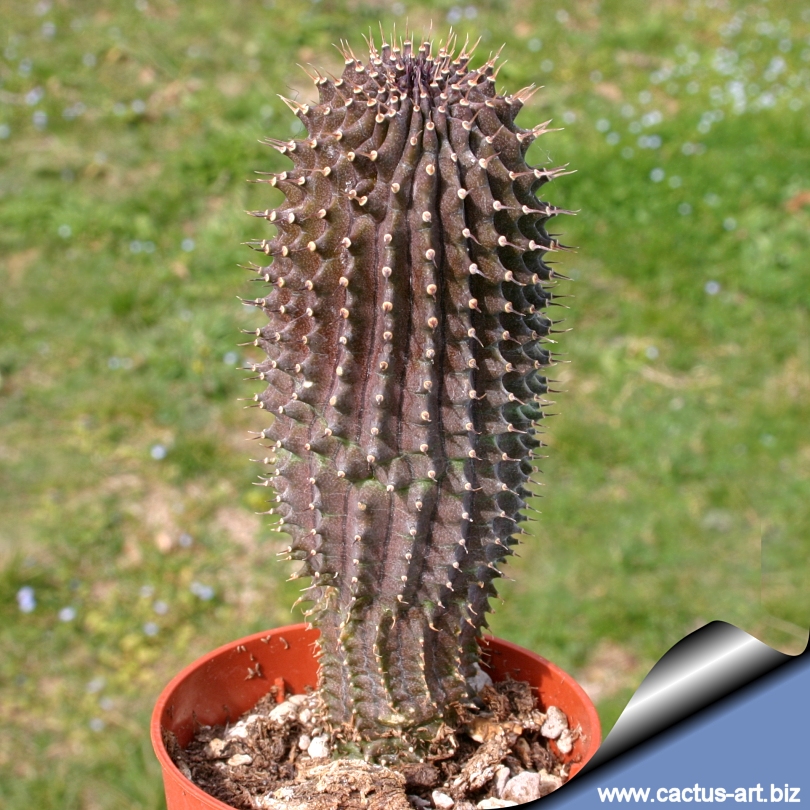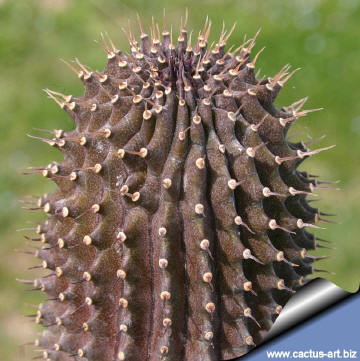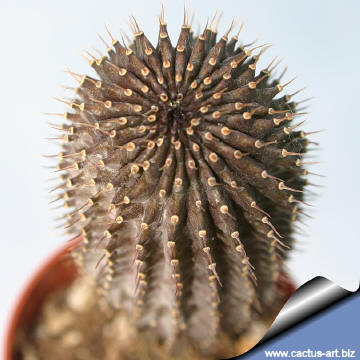|
|
|

Hoodia pilifera ( a red tinged form )
|
|
Description: Leafless fat-stemmed
succulent 50-80 cm in height, with fleshy,
ribbed and thorny stems arising from a common base. It will form large
group up to 2 m in diameter (but usually much smaller)
Stem: Stricltly
cylindrical up to 80 cm tall, 3-6 cm in
diameter,
dark green to pale grey green (sometime with a
purple hue).The
knobbly surface helps to scatter the sun's radiation, minimising the
amount of heat they absorb.
Ribs: 21-34 with laterally flattened tubercles each of them with
a grey or brownish apical flexible bristle like spine 3-9 mm long.
Flowers: Saucer-shaped/campanulate,
inside dark purple to almost black or pinkish brown, outside reddish
green, with a smell of decaying flesh to attract flies and blowflies
(the main pollinators). The flowers are solitary or in small
inflorescences with up to 3 frowers. Pedicel 0.5-1.5 mm long.
Blooming season: Flowers are normally borne in August or September.
Hoodia takes duration of 5 years to be completely mature, till its
flowers appear.
Fruit: The seed capsules resemble the
horns of a goat and contain numerous seeds.
Seeds: The seeds are light
brown in colour, are flat and have a pappus of fluffy, silky hair
attached to their one end. This pappus acts as a parachute when the seed
pod splits open. The seeds are blown some distance from the parent plant
where they will establish themselves.
Three subspecies of H. pilifera are known:
- subsp. pilifera: flowers
purple-brown, up to 20 mm in diameter.
- subsp. annulata: flowers dark
purple to black, 20-30 mm in diameter, with spreading lobes.
- subsp. pillansii: flowers yellow
to pinkish, without the raised rim (annulus) as in the other
subspecies.
|
|
 |
 |
|
Advertising
|
|
|
|
|
Family:
Asclepiadaceae (Apocynaceae) (Milkweeds family)
Accepted
Scientific name: Hoodia
pilifera (L.f.) Plowes subsp. pilifera (L.f.) Plowes
In: Asklepios No. 56:10,1992
Hoodia pilifera was the first species of the genus to be
discovered by Thunberg and Masson near Oudtshoorn between 1772 and 1774
Origin: South Africa (Western Cape, Little and Geat Karoo)
Habitat: Grows in arid areas of at around
300-900 m of altitude.
Ecology: Pollination is done
mainly by flies. This unusual pollination biology is referred to as
myophily (pollination by flies). Myophily takes place in some of the
following genera, Stapelia, Huernia and Ceropegia. Life for a young
Hoodia plant begins under the protection of a nurse plant. A nurse plant
is a shrub under which the young plant germinates and grows, protected
by its leaves and branches from the suns strong rays.
Conservation status: Listed in
CITES appendix 2.
Common English Names include: Hoodia
Etymology: It has been named
in honour of Van Hood, a keen succulent grower while the species name
comes from Latin "pilus", "hair; trifle" + "i" connective vowel used by
botanical Latin and from Latin "fero", "to bear, carry, bring" referring
to the apical hairy spines found on the tip of each tubercles.
Synonyms:
- Stapelia pilifera Linné fil.
In: Suppl. 171; Thunb. Fl. Cap. II. 1781
- Trichocaulon piliferum (L.f.)
N.E.Br. 1873
- Piaranthus piliferus (Linné fil.)
Sweet 1830
Note:
The Systematics in Hoodia are, like in almost
any other plant group, always fully unfinished and open to discussion
among the different authors.
There are many difficulty in
Hoodia identification. If we have some plants from unidentified origin (
plants provided unlabeled or with poor identification data), we have to
wait until the plant is in flower and also specialists and growers have
quite a difficulty to identify correctly this plants.
|
|
|
|
Cultivation:
It is one of easiest
species to grow but prone to root rot due to overwaterings and lack of
fresh air. Water normally
in the
growing season, sparsely in the winter. It is usually recommended to
over-winter
them in warm conditions (at 10° C),
but despite their African
origins they seem
to grow well and flower without the extra heat which one might have
thought necessary, and
occasional temperatures
near 0°C (or less).
are tolerated, if kept
dry.
Spring:
In
the spring leaving them out in the rain may provide them with the
water they need.
Summer:
In
the summer months they will grow well in
full sun or
partial shade and tolerate heavy
rain, but will be just as happy if the season is
dry.
Potting medium:
Since roots are quite shallow, a gritty,
very free-draining
compost with extra
perlite or
pumiceis suitable, and
clay pots help the plants to dry out between watering.
Indoors only in brightest
position,
Propagation:
Propagation is done mainly from seed.
Cuttings are not really an option, as the severed ends very rarely form
a callus from where roots will eventually form. Seeds are produced in
March and April of each year (Europe). The seed horns must be semi-dry
and starting to split down the middle before seed can be collected.
If you try to take a cutting allows it to
dry several days
before
planting.
USES:
In its native country of South Africa it is referred to by the
indigenous people Khoi-San herders as “ghaap”, “guaap”, “or ngaap” were
they use it as a convenient emergency food and moisture source in harsh
arid environments. Hoodia pilifera has an insipid, yet cool and watery
taste. The plant is edible in its raw state or preserved in sugar.
The young pod are liked for their sweetnees
Similarly to Hoodia gordoni and several other succulents known as
carrion flowers or stapeliads this species can be used as an appetite
and thirst suppressant. A small piece of the stem is peeled to remove
the thorns and is eaten fresh. The optimal dose is not yet known.

 |
|